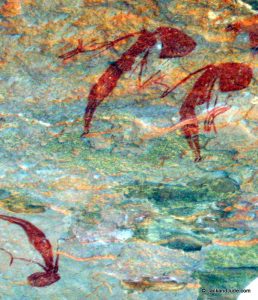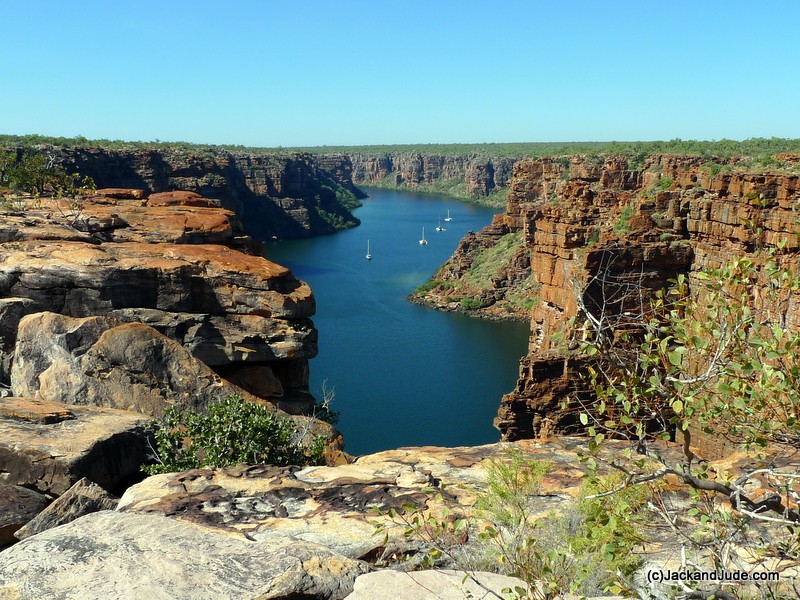July 2018 June 2018 >>
Blog of Jack and Jude
explorers, authors, photographers & videographers
Two remote destinations
Do you love wild outposts of Nature, where the creatures don’t scurry away but instead come in for a closer look? Do you love being all alone surrounded by soaring peaks, with great walks and good fishing?
If you’ve been toying with the thought of sailing across the bight to Western Australia or coming east from the west coast, then here are two places that will offer a magical experiences and a place to rest.
Daw Island
We’re guessing that you’ve never heard of this droplet of land that pops out the turbulent Southern Ocean twenty miles from Isrealite Bay in Western Australia. A few years ago, we sailed past it on our way west, but didn’t stop as we had wind for many more miles. So this time when going east, we were keen to explore Daw Island. Especially after Ted, our ex-tuna fisherman friend in Albany told us that Daw Island once had a tuna processing ship stationed there during the fishing heyday of the 70s.

 Today Daw Island is an outpost of Nature, a lonely island at the very eastern end of the remote Recherche Archipelago, impossible to visit without a stout vessel and the courage to face Australia’s south coast. Very few visit, mostly fishermen and few yachtsmen, but hardly any pleasure boats venture out that far from help.
Today Daw Island is an outpost of Nature, a lonely island at the very eastern end of the remote Recherche Archipelago, impossible to visit without a stout vessel and the courage to face Australia’s south coast. Very few visit, mostly fishermen and few yachtsmen, but hardly any pleasure boats venture out that far from help.
Wild creatures live on Daw Island. Cute comical sea lions, majestic sea eagles, plump geese, muttonbirds, penguins, and deadly snakes all coexist with a myriad of other birds and critters that living away from man and his needs. At Daw Island, these creatures raise their families unmolested, far removed from the human specie. At Daw, Nature dominates. And that makes this place special. [Read More]
Investigator Islands
Facing the Great Southern Ocean, this remote outpost for Nature seemed to beg to be investigated, and so we planned to anchor there overnight if conditions allowed. Lying 55 miles west of Esperance, and 15 miles from the mainland, the Investigator Islands, which were originally called Rocky Isles and then renamed to honour Flinders’ ship, are no more than two gigantic granite boulders rising out tempestuous seas.
 |
| In 1802, Matthew Flinders wrote, “Rocky Islets (Investigator Islands): low, smooth, sterile, frequented by seals” |
| Approaching the anchorage | Hard white sand bottom – but very deep |
When first sight ten miles ahead, we were in seventh heaven flying a full main and headsail poled out, both filled by a gentle breeze, our first since leaving Adelaide eight weeks earlier. Gazing at the approaching humps gaining colour and taking shape, Jack was on the aft deck cleaning a recently caught two-meal tuna while Jude prayed the mild swell would not have much affect in the bay trapped between the islands.
These islands are the furthest west in the Recherche Archipelago that contains many areas not surveyed. Therefore, using our chart just as an indicator, we cautiously sailed into this bay that is surrounded by rising granite rock and then carefully skirted the shallow patch off its head, before proceeded with extreme caution expecting the bottom to rise suddenly. Looking about, we saw no sandy beaches, just steep bare rock all around, and so it did not surprise us that we had to sink our anchor into great depths.
| Cleaning out accumulated Ribbon Grass from anchor locker | Our first sight of Sea Lions. Jude’s off to retrieve her camera |
Once settled, our next look about found sea-lions littering the rock slopes. Too late to row around, but we didn’t mind, in half an hour the sun would be molten gold behind black rock, providing heaps to see from our floating home. A group of what we thought were NZ fur seals were cavorting about in the rocky gap between the two islands, their dark shapes starkly contrasting against the white breaking southern ocean swells seething with foam. Through binoculars, their dripping wet coats reflected the orange glow of the setting sun through which sea-birds were already flying home.
Around us the world is wild, stark, menacing. While downstairs it’s warm and cosy. The transition swift, absolute. Upstairs, orange and amber red succulents carpeted the pink granite massifs that form the backdrop to dark creatures lugging their slug-like bodies up slopes, or posturing, heads aloof, princely, regal, while overhead against scudding darkening grey, forked tailed terns dart, their eyes striped black – inquisitive, hanging perilously aloft on lopping fragile wings. [Read More]
Jude’s fall that broke her knee in the Kimberley in 2013
With Jude’s latest mishap attracting attention, we thought it appropriate to look back over her catastrophic fall in the remote Kimberley region in 2013.
Dreams and Disasters
Dreams can build empires and send men into space. They are the mortar that bond Jack and Jude. Without one, instead of admiring our partner’s strengths we notice their faults. On the other hand, with a dream we meld into a team that will sacrifice comfort and take risks in our quest for a full and meaningful life. But, what happens when a dream is shattered like a precious stained glass window hit by hailstones?
We are now adrift in a hot, windless, lonely part of northern Australia, writing to report that disaster has struck our Kimberley Adventure.
After leaving our home port, we had sailed so many miles in so short a time that during a walk to find our land legs, Jude took a tumble that has now become something of a nightmare. That’s because after two weeks of bed rest taking handfuls of anti-inflammatory painkillers, she’s still unable to stand, and so we are now attempting to reach help by the only means available to us – sail power.
Voyage went smoothly
Our voyage into this wilderness went smoothly enough with a non-event three day crossing of the Joseph Bonaparte Gulf from Darwin that landed us at Gallery Bay, a tiny notch in the rocky red Kimberley coastline that’s impossible to discern until metres from its rocky headland. In 2007, we had explored inland from this nick after hearing of ancient rock art hidden up its tiny inlet and found rock towers adorned with Bradshaw Art thought to be the oldest art in the world. We also discovered Gallery Bay has another precious commodity in this vast dry land – freshwater. Only a trickle, but clear and sweet.
It was finding water that gave birth to a dream. When back home remembering our Kimberley experience and the heat, sandflies and inability to enter crocodile infested water, the Bradshaw Art we’d discovered overpowered all those nasties. They were special moments to cherish. So, in planning this journey, we thought we’d take it to a new level. We had learnt that the ancient ones had commanded the ground between the King George East Arm, which also has fabulous paintings, and Gallery Bay, six kilometres across a ridge. The King George River offered secure anchoring for Banyandah, and a dream formed where if had potable water, we could explore that area for as long as we wanted. Who knows what mysteries we’d then discover amongst the dry creeks and rock towers?
 Within an hour of entering Gallery Bay and planting our new BOSS anchor into Kimberley mud, we were boarding Little Red, eager to find water after the poor wet season that had been followed by a severe dry. On croc alert in our tiny tinny, earlier snapshots of this ancient place flashed through our heads as we rounded the inlet, where again we were gob-smacked by rock towers honeycombed with caves and overhangs that had once been the home for some of Earth’s earliest people. Surrounded by such strangely coloured stone, we expected Fred Flintstone and Barney to pop out any moment.
Within an hour of entering Gallery Bay and planting our new BOSS anchor into Kimberley mud, we were boarding Little Red, eager to find water after the poor wet season that had been followed by a severe dry. On croc alert in our tiny tinny, earlier snapshots of this ancient place flashed through our heads as we rounded the inlet, where again we were gob-smacked by rock towers honeycombed with caves and overhangs that had once been the home for some of Earth’s earliest people. Surrounded by such strangely coloured stone, we expected Fred Flintstone and Barney to pop out any moment.
In the tranquillity of late afternoon, the melodious tunes of unseen birds echoed off the silent water until our movements set a colony of bats into flight from the mangroves, their backlit paper-thin wings showing their bones as if an ink drawing. Approaching our previous landing place, the same flat ledge received our transport. Then stepping ashore our eyes automatically rose to an overhang where again we beheld three maroon-red angels painted upon hard rock thirty millennia ago.
With speed we rock hopped and tramped thorny vegetation up the creek, our ears straining for the first sounds of running water while our eyes noted dry pools coated with hard scum that had our minds wondering whether our adventure would go ahead. With this thought in my head I rushed ahead, first finding a stagnant pool, and then to my great relief I heard a faint trickle under the dark rocks. Climbing up another level and pushing through thick bushes revealed a tiny water hole shaded by lush green Pandanus with their barbed fronds littering the rocks. There was further joy when I found a sandy patch suitable for a camp, and as Jude pushed her way through to join in my elation, I entered a waypoint into our handheld GPS, giving us a mark to aim for from the King George anchorage.
Dawn two days later, on a tide showing less than knee depth under our keel, Banyandah crept across the sandbank that bars entry into the King George River and its famous twin falls. The tide cycle there is unusual, sometimes four tides each day, sometimes two, as it would be for the next few weeks. Therefore, we’d either be inside for two weeks or have to brave a dark night exit.
Jude had felt giddy during our Gallery Bay walk – “Haven’t found my land legs yet,” she had laughed. So before we hefted heavy packs and headed overland, we thought a day’s march up and around the top of King George Falls would sharpen our balance.
That very same afternoon, from beneath the falls we climbed the steep rocky slope to gain a magnificent view down upon the red rock gorge where Banyandah lay like a blue water beetle, the only keelboat amongst three multihulls.











